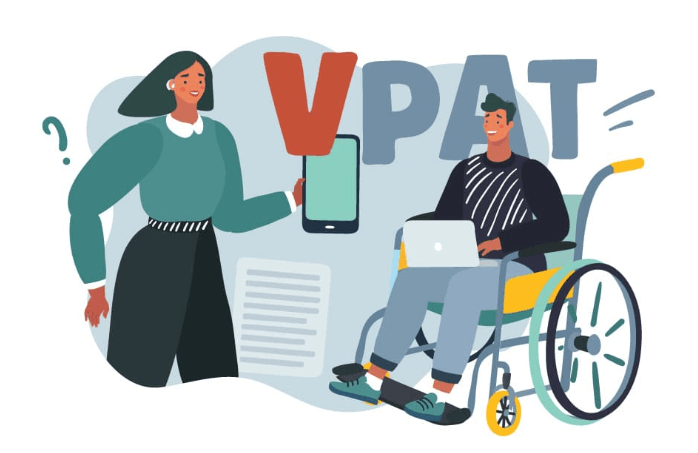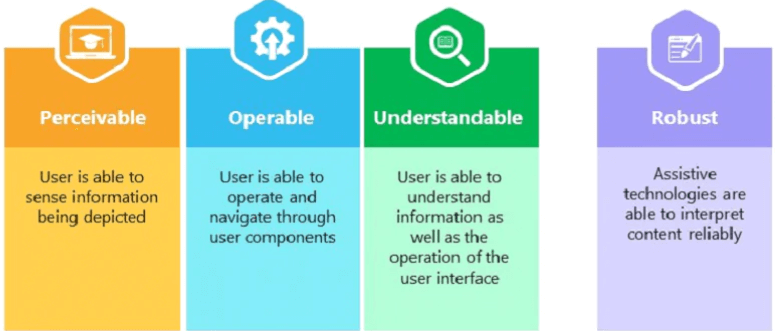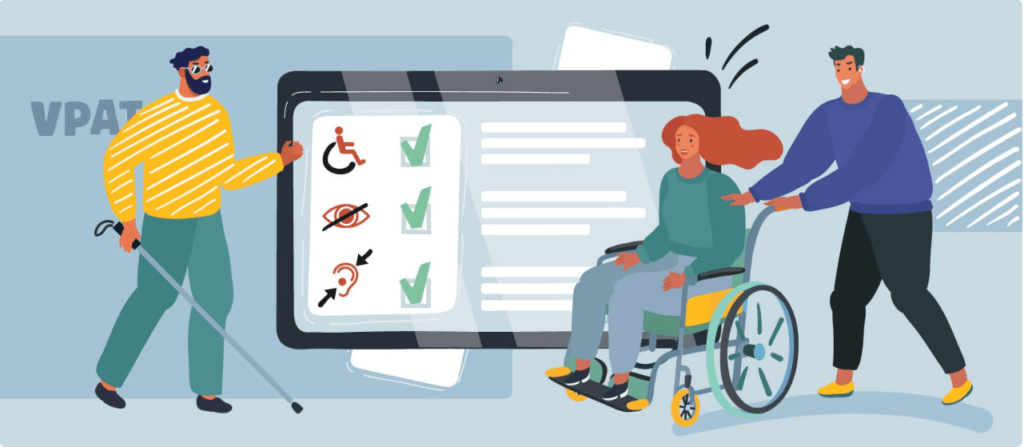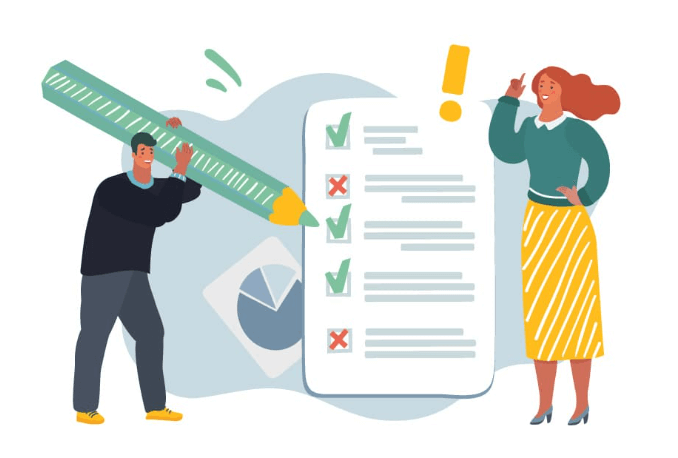Executive Summary
A VPAT® is a document outlining how ICT products conform to Revised 508 Standards for IT accessibility. It covers software, hardware, electronic content, and support documentation. VPAT® aids federal agency officials and government buyers in assessing ICT accessibility during market research and proposal evaluation.
Normally government solicitations that involve ICT must state accessibility requirements. And clearly indicate the mandatory provisions to ensure the deliverable’s accessibility. Accordingly a VPAT® is a good way to address the accessibility requirements defined in the solicitation.
The outcome of a completed VPAT® is an Accessibility Conformance Report (ACR). An ACR measures conformance to Section 508 standards of ICT. This happens before Federal agencies develop, procure, fund, maintain, or use a specific version. As a result, you need a continuous assessment for each iteration and/or instance.

Introduction
The Information Technology Industry Council (ITIC) creates the Voluntary Product Accessibility Template (VPAT®), which is a comprehensive document. Federal Government contracting officials and buyers can make preliminary assessments on the commercial availability of accessible ICT products and services.
The VPAT® allows ICT product manufacturers and vendors to self-report compliance with standards like Section 508. It includes details on implementation, testing, and known defects on a provision-by-provision basis.
The updated VPAT® 2 format incorporates international standards such as WCAG, Section 508, and the European standard EN 301 549. There are four versions of the template for each standard and one that includes all standards.
The product manufacturer or vendor should use a consistent table format. This indicates how their product meets each technical and functional requirement of the applicable standards.
A complete VPAT report provides a comprehensive breakdown of the following information:
- The accessibility requirements that are relevant to a specific product.
- The extent to which the product aligns with each guideline, indicating its level of conformance.
- An explanation of how the product meets each guideline.
Significance of Accessibility Conformance Reports (ACRs)
The Voluntary Product Accessibility Template® (VPAT®) is in fact a mandatory requirement for vendors selling to the U.S. Federal Government.
Moreover, it holds significant importance for vendors selling to public and private sector entities within the United States and worldwide. Product manufacturers and vendors should establish a clear process for preparing Accessibility Conformance Reports (ACRs) to meet these requirements effectively.
The Accessibility Conformance Report (ACR) serves as a comprehensive overview of the accessibility status of your digital products. You can share it with your customers and anyone inquiring about the accessibility of your digital products.
Individuals with comprehensive knowledge of digital accessibility requirements and thorough testing procedures should diligently prepare these reports. Product manufacturers and vendors can guarantee the comprehensiveness and accuracy of their accessibility conformance reports in VPAT® format.
For vendors
Vendors require an ACR to consider digital product(s) for acquisition.
For program teams
An ACR is necessary to assess and evaluate the conformance risk level the digital product(s) poses to the Federal agency. The digital product(s) is high risk when the ACR conformance level indicates a result of “does not support.” In these instances, the procurement process may require reconsideration of the digital product(s).
History and Use of the VPAT®
ITI positions itself as the global advocate for the technology sector in matters related to advocacy and public policy. Its membership consists of major hardware, software, and services companies operating worldwide.
In 2001, ITI collaborated with the GSA to develop the Voluntary Product Accessibility Template (VPAT®). The primary objective of VPAT® was to streamline the procurement process of accessible ICT products and services for U.S. Federal Government agencies. VPAT documents must comply with the technical and functional performance requirements of Section 508.
Over time, ICT product manufacturers and vendors have to demonstrate adherence to multiple ICT accessibility standards. So the ITI drafts VPAT to encompass the changes introduced in the Revised 508 Standards, published in 2017. This update includes referencing the Web Content Accessibility Guidelines 2.0. VPAT 2 allows reporting against WCAG 2.0 or WCAG 2.1, as well as the European standard EN 301 549.
Specifically, VPAT® 2 supports documentation of conformance to:
- Section 508 Refresh 2017 (Chapters 3, 4, 5 and 6)
- WCAG 2.0 Success Criteria & Conformance Requirements (Levels A, AA, and AAA)
- WCAG 2.1 Success Criteria & Conformance Requirements (Levels A, AA, and AAA)
- EN 301 549 (Chapters 4-13)
VPAT® 2
ITI has rebranded the original VPAT® as VPAT 1.0 and introduced an updated version called VPAT® 2. The most recent release of VPAT® 2 occurred in April 2019. The new template, VPAT® 2, offers comprehensive instructions and best practices to assist in completing the document effectively.
As per the updated guidance provided by the Federal Acquisition Register (FAR) and upon request from individual U.S. Federal agencies, vendors must provide an Accessibility Conformance Report (ACR) in VPAT® 2 format for procurement of product or service.
Vendors should closely follow any U.S. Federal agencies requirements. Because some agencies may still request VPAT® reports in the VPAT® 1.0 format. VPAT® 2 simplifies the conformance criteria by dividing them into removable sections if they are not applicable. However, it is important to note that entire sections are removable, but not individual criteria.
VPAT® 2 Standards and Guidelines
Section 508
The Rehabilitation Act of 1973’s Section 508 mandates that U.S. Federal government agencies must ensure equal access to information and data for federal employees and the public with disabilities. This requirement applies to the development, procurement, maintenance, and utilization of electronic and information technology (referred to as ICT in the current standards). The only exception is if implementing such access would unreasonably burden the agency.
Section 508’s legal restrictions apply exclusively to the federal sector and do not directly impact the private sector or impose obligations on recipients of federal funds. However, some federal agencies may use Section 508 standards as guidance for organizations receiving their funds. Furthermore, several U.S. states and specific local public sector entities like government agencies and publicly funded educational institutions have adopted the Section 508 standards and include them in their procurement procedures.
WCAG 2.0
The Web Content Accessibility Guidelines (WCAG 2.0) are a set of international standards of accessibility by the W3C. These standards are based on 4 core principles for web accessibility.
Perceivable: Users must be able to identify content and interface elements with at least one of their senses.
Operable: Users must be able to use all controls, buttons, navigation options, and other interactive elements on a digital interface.
Understandable: Users must be able to understand the information as well as the operation of a digital interface.
Robust: The digital content must be robust enough for interpretation by a wide variety of user agents, including assistive technologies.

Figure 1: WCAG POUR Principles
EN 301 549
EN 301 549 is a digital accessibility standard in the European Union (EU) in response to a request by the European Commission. It applies to public sector websites and mobile apps throughout the EU. As of January 2017, EN 301 549 became the standard for accessible procurement in Europe The current version of EN 301 549 v 2.1.2 incorporates WCAG 2.1 criteria.
Using VPAT® for Various Product Categories
To support compliance with Section 508 for U.S. Federal contracting and procurement officials, the GSA created the “Accessibility Requirements Tool (ART).” This tool generates sample procurement language and statements outlining accessibility requirements. These documents serve as explicit notifications of the Section 508 requirements for the procurement of ICT.
Vendors must incorporate their responses to these requirements in their proposals. They must showcase how their proposed solution aligns with the applicable Section 508 requirements.
VPAT® 2 Best Practices
Below are some best practices to keep in mind when using the VPAT® 2 template:
- The VPAT® 2 document has two sections, instructions for usage and the conformance template.
- Maintain the accuracy and currency of your Accessibility Conformance Report (ACR).
- Ensure an individual well-versed in accessibility laws and standards completes the ACR.
- Avoid the common error of merely stating “supported” or “not supported” for an accessibility criterion when completing the VPAT.
- If feasible, consider publishing the completed ACRs on your company website or making them available upon customer request.
Who needs a VPAT®?
Any business or organization that has to demonstrate the compliance of their ICT with Section 508 standards has to produce a VPAT®. Companies participating in government-related business transactions may need to submit an Accessibility Conformance Report (ACR) or a Voluntary Product Accessibility Template (VPAT®). This is necessary to evaluate the accessibility of their information and communication technology (ICT) products.
Similar to Section 508, Section 504 prohibits entities that receive federal financial assistance from engaging in discrimination against individuals with disabilities. This implies that ICTs must be accessible as part of federal procurement initiatives. This requirement extends to the procurement processes of state, local, tribal, territorial, and public educational institutions.

When is a VPAT® required?
When a Federal government agency requests it, a Voluntary Product Accessibility Template (VPAT®) becomes mandatory. A contracting official or a government buyer typically makes this request. Adherence to Section 508 is necessary to secure a contract with the federal government, and completing a VPAT® is part of this requirement.
The VPAT® demonstrates the accessibility compliance of information and communication technologies (ICTs) during federal procurement. However, it’s important to consult the contracting officer for specific guidance. Since different agencies have their own reporting requirements and require additional documentation.
Here are some steps to fill a VPAT® and submit a winning proposal
Step 1: Audit Your Accessibility
Before beginning the VPAT process, conduct a comprehensive audit and develop a checklist to identify areas for improvement in your web presence.
Step 2: Complete the Voluntary Product Accessibility Template (VPAT®)
Visit the official website of the Information Technology Industry Council to obtain the latest VPAT. Consider involving an expert due to the extensive nature of the process, as some VPAT® can span up to 10,000 pages, requiring technical knowledge and evaluation skills.
Step 3: Ensure Integrity
Maintain up-to-date documentation and be truthful in your data representation. Establish a standardized procedure for accuracy testing and implementing changes.
Step 4: Publish the VPAT®
Finally, provide a link to your VPAT® on your official website or ensure it is available upon request. This makes it accessible to interested parties.
Additional reasons to complete a VPAT®
Ensure Compliance with the Americans with Disabilities Act (ADA)
Under Title III of the ADA, your company’s online presence must be accessible as it falls under the category of a “place of public accommodation.”
Adhere to Web Content Accessibility Guidelines (WCAG)
By utilizing a VPAT®, you can evaluate your product’s compliance with WCAG 2.0 standards.
Conform to EN 301 549
Adhering to EN 301 549 is crucial for maintaining accessibility compliance in European jurisdictions.
Advantages of using a VPAT®
Business organizations, individuals, and governments benefit from using a VPAT®. Here are some of the advantages.
Enhancing Accessibility
Discrimination against individuals with disabilities infringes upon fundamental human rights. By utilizing VPATs, organizations not only foster inclusivity but also experience rapid business growth.
Mitigating Legal Risks
You can take proactive measures, such as conducting an accessibility audit of your ICT products and services. Creating a VPAT®, can help reduce the potential for legal action under current federal and state laws.
Ensuring Compliance
Non-compliance with accessibility standards increases legal risks under the ADA. Consequently the risk of potential lawsuits with expenses reaching tens or hundreds of thousands of dollars is a possibility.
About codemantra
codemantra has over two decades of experience working with state and local government agencies, higher education institutions, and the commercial sector. We help them fulfill their digital accessibility responsibilities and goals.
codemantra’s accessibilityInsight™ is an AI-powered platform to assess and remediate documents to global accessibility standards. The platform makes digital assets, including PDF, audio, video (CC), and URL links, accessible for print-disabled citizens. The output is compliant as per PDF U/A standards and WCAG 2.1 Level AA guidelines.
codemantra conducts testing of customer products for conformance to WCAG 2.1 AA guidelines. We identify deficiencies, and provides VPAT®s (Voluntary Product Accessibility Templates) to assist buyers in evaluating product accessibility.
Every client engagement entails a thorough consultancy and discovery process to customize the approach based on subject expertise and workflow experience. This guarantees that most effective path forward.
How codemantra can help?
codemantra can help product manufacturers and vendors to prepare the Accessibility Conformance Reports (ACRs). We can ensure that the individuals responsible for their preparation possess extensive knowledge of digital accessibility requirements and testing procedures. If internal resources lack this expertise, it may be beneficial to consider engaging an accessibility expert like codemantra.
Testing for Compliance with Multiple Standards
Before drafting the ACR, codemantra can conduct an Accessibility audit to provide an accurate assessment of your current level of compliance. The audit will identify and prioritize accessibility issues within your ICT system. We will outline methods for addressing these issues, and document adherence to Section 508, and other standards.
codemantra employs a proven audit methodology with comprehensive documentation, deep expertise, and a data-driven governance process.
Preparing ACRs
With over two decades of experience in digital accessibility, codemantra possesses extensive expert knowledge of all ICT accessibility laws and standards. Leveraging this experience and expertise, we have crafted numerous ACRs over the years. Thus enabling our clients to fulfill their obligations as suppliers to organizations that require conformity to various accessibility standards.

Our Services and Solutions
Remediation Services: Following the audit, we can assist you in addressing the most prominent issues to increase your chances of securing government contracts.
Policy and Program Services: codemantra can help evaluate your existing digital accessibility programs, policies, and resources or develop them from scratch. This includes implementing processes that ensure consistent product testing for compliance with multiple standards. We assist you to create and maintain VPATs. We also provide expertise to incorporate accessibility standards conformance into your contracting and procurement procedures.
Training Services: We offer training to your employees on designing, developing, and testing accessible products and services.
Support Services: We provide support services to address your digital accessibility needs and requirements . Our most experienced subject matter experts will handle your requests and needs on a priority basis.
For more information on fulfilling VPAT®s and ACR requirements reach out to us: engage@codemantra.com









